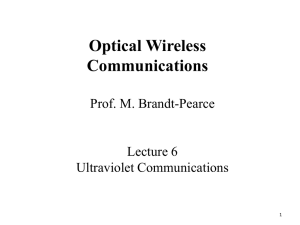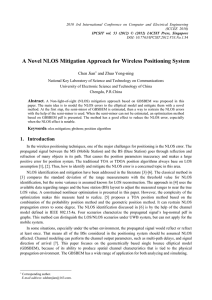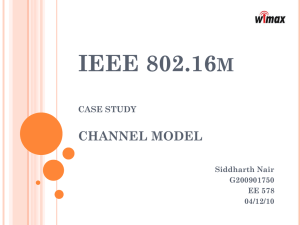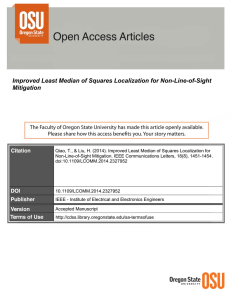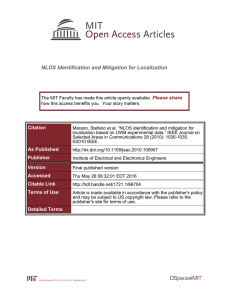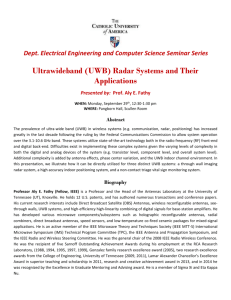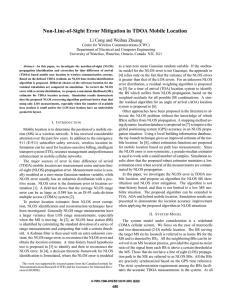Nonparametric obstruction detection for UWB localization Please share
advertisement
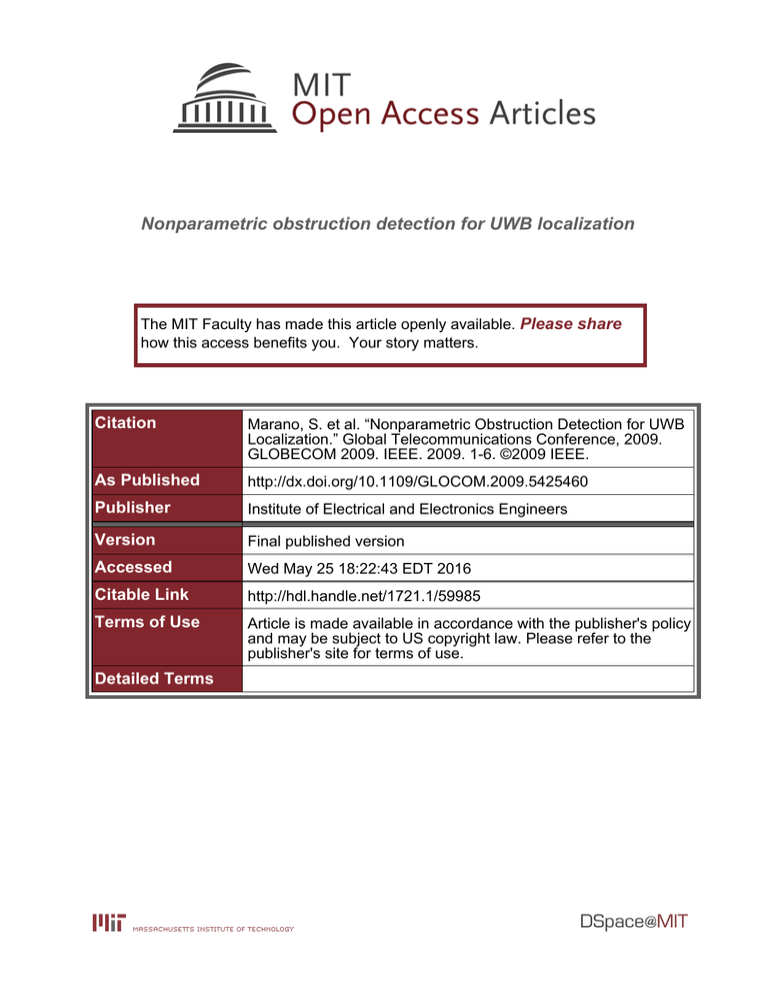
Nonparametric obstruction detection for UWB localization
The MIT Faculty has made this article openly available. Please share
how this access benefits you. Your story matters.
Citation
Marano, S. et al. “Nonparametric Obstruction Detection for UWB
Localization.” Global Telecommunications Conference, 2009.
GLOBECOM 2009. IEEE. 2009. 1-6. ©2009 IEEE.
As Published
http://dx.doi.org/10.1109/GLOCOM.2009.5425460
Publisher
Institute of Electrical and Electronics Engineers
Version
Final published version
Accessed
Wed May 25 18:22:43 EDT 2016
Citable Link
http://hdl.handle.net/1721.1/59985
Terms of Use
Article is made available in accordance with the publisher's policy
and may be subject to US copyright law. Please refer to the
publisher's site for terms of use.
Detailed Terms
Nonparametric Obstruction Detection for
UWB Localization
Stefano Maranò∗ , Wesley M. Gifford† , Henk Wymeersch‡ , and Moe Z. Win†
∗ Swiss
Seismological Service, ETH Zürich, Zürich, Switzerland
Email: stefano.marano@sed.ethz.ch
† Laboratory for Information and Decision Systems, Massachusetts Institute of Technology, Cambridge, MA 02139
Email: wgifford@mit.edu, moewin@mit.edu
‡ Chalmers University of Technology, Göteborg, Sweden
Email: henk.wymeersch@ieee.org
Abstract—Ultra-wide bandwidth (UWB) transmission is a
promising technology for indoor localization due to its fine delay
resolution and obstacle-penetration capabilities. However, the
presence of walls and other obstacles introduces a positive bias in
distance estimates, severely degrading localization accuracy. We
have performed an extensive indoor measurement campaign with
FCC-compliant UWB radios to quantify the effect of non-line-ofsight (NLOS) propagation. Based on this campaign, we extract
key features that allow us to distinguish between NLOS and LOS
conditions. We then propose a nonparametric approach based on
support vector machines for NLOS identification, and compare it
with existing parametric (i.e., model-based) approaches. Finally,
we evaluate the impact on localization through Monte Carlo
simulation. Our results show that it is possible to improve
positioning accuracy relying solely on the received UWB signal.
Index Terms—NLOS Identification, Support Vector Machine,
UWB.
I. I NTRODUCTION
Location-awareness is fast becoming a fundamental aspect
of wireless networks and will enable a myriad of applications, in both the commercial and the military sectors [1].
Ultra-wide bandwidth (UWB) transmission provides robust
signaling, as well as through-wall propagation and highresolution ranging capabilities [2], [3]. Therefore, UWB is a
promising technology for location-aware applications in harsh
environments with stringent operational requirements [4], [5],
such as indoor navigation and simultaneous localization and
mapping (SLAM).
A number of implementation challenges remain before
UWB systems can be deployed on a large scale. These include
signal acquisition, multi-user interference, multipath effects,
and non-line-of-sight (NLOS) propagation. The latter issue is
especially critical for high-resolution location-aware applications, since NLOS propagation introduces positive biases in
distance estimation algorithms, which can seriously affect the
localization performance [3], [6]. Typical harsh environments
such as enclosed areas, urban canyons, or tree canopies inherently have a high occurrence of NLOS situations. It is therefore
critical to: (i) understand the impact of NLOS conditions on
localization systems; and (ii) develop techniques that counter
their effects.
A typical localization system comprises two stages: a ranging stage and a localization stage. In the ranging stage, signals
are exchanged between devices, based on which relative angles
or distances can be estimated. This relative position information is commonly based on signal arrival times (assuming a
known propagation speed) or received signal power (assuming
a known path loss). In the localization stage, the relative
position information is combined with absolute position information (e.g., anchor positions) resulting in a position estimate.
NLOS propagation impacts the ranging stage, since signals
propagating through materials undergo an additional delay
and power reduction. Moreover, when the direct line-of-sight
(LOS) path is completely blocked, signals that arrive at the
receiver via reflected paths, also exhibit delays and power
reductions. In either case, any distance estimates in NLOS
conditions will be positively biased.
NLOS identification attempts to distinguish between LOS1
and NLOS conditions, and is commonly based on range
estimates, on the channel impulse response (CIR), or on coarse
position estimates [7]–[11]. The first class of techniques relies
on the analysis of a history of range estimates, and often
requires a large number of observations, which results in
significant latency [7]–[9]. The second class of techniques
relies on a single received signal, based on which the channel
is identified as being either LOS or NLOS [10]. No additional
latency is incurred. In [10], a likelihood ratio test is proposed
to discriminate between the LOS and NLOS condition, based
on statistics extracted from the channel response, and is
evaluated using the IEEE 802.15.4a channel model. The third
class of techniques combines range estimates from different
sources to compute a coarse position estimate. When there
is sufficient redundancy, NLOS estimates can be identified
[11]. A detailed overview of NLOS identification techniques
can be found in [8]. We note that all these works on NLOS
identification are based on statistical techniques or on ad-hoc
methods.
In this paper, we propose a nonparametric approach using machine learning techniques that does not require any
1 Throughout this paper the term LOS is used to denote the existence of a
visual LOS. Specifically, a signal is considered as LOS when the straight line
between the transmitting and receiving antenna is unobstructed.
978-1-4244-4148-8/09/$25.00 ©2009
This full text paper was peer reviewed at the direction of IEEE Communications Society subject matter experts for publication in the IEEE "GLOBECOM" 2009 proceedings.
1
5
2.5
Amplitude [ADC counts/1000]
0.8
CDF
0.6
0.4
0.2
LOS
NLOS
0
0 1
5
10
15
0
−2.5
−5
−30
−20
−10
CDF of the ranging error for the LOS and NLOS conditions.
statistical characterization of LOS and NLOS channels. Furthermore, our approach is based directly on the UWB CIR
and thus avoids any latency issues. To validate our identification algorithms, we use results from a recent indoor
measurement campaign with FCC-compliant UWB radios,
rather than relying on statistical channel models. Hence, our
results give a realistic indication of real-world performance.
We evaluate the performance of our proposed techniques, both
in terms of identification error rate and in terms of localization
performance, and compare with existing techniques.
The remainder of this paper is organized as follows. In
Section II we briefly describe the measurement campaign. In
Section III we detail different approaches to NLOS detection,
including our novel nonparametric method. In Section IV we
provide detailed numerical results, followed by our conclusions in Section V.
II. M EASUREMENT C AMPAIGN
During Fall 2007 the Wireless Communication and Network Sciences Laboratory performed a detailed measurement
campaign at the Massachusetts Institute of Technology. The
measurements were made with two small radios capable of
performing communications and ranging using impulse-radio
UWB signals. Each radio complies with the emission limit
set forth by the FCC [12] and has a 10 dB bandwidth from
3.1 GHz to 6.3 GHz. The radio runs a round-trip timeof-arrival ranging protocol and is capable of simultaneously
capturing a waveform. Each waveform, which is affected by
thermal noise, is sampled with Tsample = 41.3 ps over an
observation window of T = 190 ns.
Measurements were taken at over 1000 transmitter/receiver
locations in an indoor office environment [13]. Since the
primary focus of this work is the impact of obstructions, measurement positions were chosen so that half of the collected
waveforms were transmitted under NLOS conditions. The
distance between transmitter and receiver varied from roughly
0.6 m up to 18 m, in an attempt to capture a wide variety
10
20
30
40
50
60
70
80
40
50
60
70
80
Time [ns]
5
2.5
0
−2.5
−5
−30
−20
−10
0
10
20
30
Time [ns]
Ranging Error [m]
Fig. 1.
0
Fig. 2. In some situations there is a clear difference between LOS (upper
waveform) and NLOS (lower waveform) signals.
of operating conditions. Along with the received waveform,
the associated range estimate and the actual distance were
recorded. The final database includes 1024 measurements, 512
LOS and 512 NLOS.
III. O BSTRUCTION D ETECTION
The collected measurement data illustrates that NLOS propagation conditions significantly impact ranging performance.
Fig. 1 shows the empirical cumulative distribution functions
(CDFs) of the ranging error under the two different channel
conditions. In LOS conditions the ranging error is below one
meter in more than 95% of the measurements. On the other
hand, in NLOS conditions the ranging error is below one meter
in less than 30% of the measurements.
In this section, we develop techniques to distinguish between LOS and NLOS conditions. Our techniques are nonparametric, and use a low-complexity least squares support vector
machine (LS-SVM) [14], [15]. We first describe the features
we use to distinguish between LOS and NLOS situations,
followed by a conventional parametric solution to NLOS
identification [10]. We then give a brief introduction of LSSVM, and describe how it can be used for NLOS identification
in localization applications.
A. Features
We have extracted a number of features from every received waveform r(t), which we expect to capture the salient
differences between LOS and NLOS signals. These features
were selected based on the following observations: (i) due
to reflections or obstructions, NLOS signals are considerably
more attenuated and present smaller energy and amplitude; (ii)
in LOS signals the strongest path typically corresponds to the
first path, while in the NLOS case some weak components
precede the strongest path, resulting in a longer rise time; and
(iii) the root-mean-square (RMS) delay spread, which captures
the temporal dispersion of the energy in a signal, is larger
in NLOS signals. Fig. 2 depicts two waveforms received in
978-1-4244-4148-8/09/$25.00 ©2009
This full text paper was peer reviewed at the direction of IEEE Communications Society subject matter experts for publication in the IEEE "GLOBECOM" 2009 proceedings.
the LOS and NLOS conditions supporting our observations.
We also include some features that have been presented in
the literature. Taking these considerations into account, the
features we will consider are as follows:2
+∞
2
1) Energy of the received signal: Er =
|r(t)| dt.
−∞
2) Maximum amplitude of the received signal: rmax =
maxt |r (t)|.
3) Rise time:
trise = tH − tL ,
=
mint {t : |r(t)| ≥ α σn }, tH
=
where tL
mint {t : |r(t)| ≥ β rmax }, and σn is the standard
deviation of the thermal noise. The values of α > 0
and 0 < β ≤ 1 are chosen empirically; in our case, we
used α = 6 and β = 0.6.
+∞
tψ(t) dt, where ψ(t) =
4) Mean excess delay: τMED =
−∞
2
|r (t)| /Er .
5) RMS delay spread (RMS-DS):
τRMS
+∞
2
=
(t − τMED ) ψ(t) dt .
−∞
6) Kurtosis:
κ=
where μ|r| =
μ|r| )2 dt.
1
4 T
σ|r|
1
T
T
T
|r(t)| − μ|r|
|r(t)| dt and
2
σ|r|
4
=
dt ,
1
T
T
(|r(t)| −
and NLOS propagation conditions, invoking an independence
assumption among features. When features are highly correlated, the independence assumption no longer holds, resulting
in degraded performance. Furthermore, the parameters for
the log-normal distributions are different for different IEEE
channel models, thus requiring a higher-level classification
during operation. To avoid these issues, we now develop a
nonparametric identification technique that does not rely on
any assumptions regarding the underlying distributions of the
features, nor their independence. Hence, it is easily extended
to various propagation scenarios and many types of features.
C. Nonparametric NLOS Identification
Support vector machines (SVMs) are supervised learning
techniques used in classification problems [16], [17]. Arguably, SVM represents one of the most used classification
techniques because of its robustness, its rigorous underpinning,
its sparse solution, the fact that it requires few user-defined
parameters, and its superior performance compared to other
techniques such as neural networks. In this work the least
squares SVM (LS-SVM) technique is employed. LS-SVM is
a low-complexity variation of the standard SVM, and has been
applied successfully to classification and regression problems
[14], [15].
In this paper, we define a classifier as a function Rn →
{−1, +1} of the form
fτMED (τMED |LOS)
fκ (κ|LOS)
×
fκ (κ|NLOS) fτMED (τMED |NLOS)
fτRMS (τRMS |LOS) LOS
≷ 1.
×
fτRMS (τRMS |NLOS) NLOS
(1)
We emphasize that the parametric approach relies on modeling the conditional distributions of the features under LOS
2 The
waveforms were processed to align the first path in the delay domain
using a simple threshold-based detector.
(2)
y (x) = wT ϕ (x) + b
(3)
with
B. Parametric NLOS Identification
In [10], a likelihood ratio test was proposed to discriminate
between the LOS and NLOS conditions. A database of channel
responses was generated from the IEEE 802.15.4a channel
model. Three statistical measures were extracted from each
channel response r(t): the kurtosis κ, the RMS-DS τRMS ,
and the MED τMED . The probability density function (PDF)
of these features for both LOS and NLOS conditions were
modeled by log-normal distributions, with parameters depending on the specific IEEE channel model. For any specific
feature we can distinguish between LOS and NLOS through
a likelihood-ratio test (LRT). In order to use all the features
jointly, the joint PDF of the three features is required. Since
this joint PDF is hard to obtain, a suboptimal solution, which
was proposed in [10], is to consider the three features as
independent, leading to the following LRT:
l (x) = sign [y (x)]
where ϕ(·) is a predetermined function, x is the classifier
input, and w and b are unknown parameters of the classifier. These parameters are estimated based on a training set
N
{xk, lk }k=1 , with inputs xk ∈ Rn and labels lk ∈ {−1, +1}.
In our case, lk = −1 corresponds to a NLOS waveform,
lk = +1 corresponds to a LOS waveform, and x is a set of
features extracted from the waveform. The LS-SVM classifier
is a maximum-margin3 classifier, obtained by solving the
following constrained optimization problem:
arg min
w,b,e
s.t.
1
1
2
2
w + γ e
2
2
lk y (x) = 1 − ek , ∀k
(4)
(5)
where γ controls the trade-off between minimizing the errors
and model complexity. The dual turns out to be a linear
program (LP):
b
0
0
lT
(6)
=
α
1N
l Ω + I/γ
where α is a vector of Lagrange multipliers, Ω is an N ×
N matrix with Ωkl = yk yl K (xk , xl ), and K (xk , xl ) =
3 The margin is given by 1/ w, and is defined as the smallest distance
between the decision boundary wT ϕ (x) + b = 0 and any of the training
samples ϕ(xk ).
978-1-4244-4148-8/09/$25.00 ©2009
This full text paper was peer reviewed at the direction of IEEE Communications Society subject matter experts for publication in the IEEE "GLOBECOM" 2009 proceedings.
T
ϕ (xk ) ϕ (xl ) is the kernel function. Solving the LP in (6)
yields the LS-SVM classifier, which is of the form:
N
αk lk K (x, xk ) + b .
(7)
l (x) = sign
k=1
D. Localization with NLOS identification
Once the agent has estimated distances with respect to
Nb ≥ 3 anchor nodes, it can estimate its location, using the
anchor positions and estimated distances.4 While there are
many algorithms that can achieve this goal, we focus on the
least squares (LS) technique, due to its simplicity and because
it makes no assumptions regarding the ranging error model.
The agent can infer its position by minimizing the LS cost
function:
N
b
2
(8)
wi dˆi − p − pi p̂ = arg min
p
i=1
where pi is the position of i-th anchor and wi is a weight
parameter, to be detailed below. In (8), some of the estimates
dˆi may correspond to NLOS conditions, adversely affecting
the final LS position estimate. Here, we investigate three
localization strategies that set the weights wi based on the
outcome of the classifier.
1) Standard: All the Nb range estimates dˆi from neighboring anchor nodes are used by the LS algorithm for
localization. Weights are set wi = 1 for 1 ≤ i ≤ Nb .
2) Identification: Signals associated with range estimates
are classified as LOS or NLOS using a classifier such
as (1) or (7), based on a set of features x. Range
estimates are used by the localization algorithm only if
the associated signal was classified as LOS, while NLOS
signals are discarded. This gives the following weights:
1
l (x) = +1
(9)
wi =
0
l (x) = −1
Note that three anchor nodes is the minimum number of
nodes needed to localize in a two-dimensional scenario.
Therefore, whenever less than three wi are set to one,
the agent is unable to localize. In this case, we set the
localization error to +∞.
3) Ranking: Estimated distances are ranked according
N to the soft-output of the LS-SVM classifier
k=1 αk lk K (x, xk )+b. The three estimates with highest ranking are retained. The weights are set wi = 1 for
the three largest soft outputs, and the remaining weights
are set to zero.
IV. N UMERICAL R ESULTS AND D ISCUSSION
In this section, we present our numerical results. In section IV-A, performance for the parametric and the proposed
nonparametric approach are reported in terms of classification
error rates. In section IV-B, localization performance is given
for simulated networks consisting of one agent and five
anchors.
4 Provided
that the anchors are not collinear.
A. Identification Performance
The performance of a LOS/NLOS identification algorithm
can be assessed through the false alarm probability and the
missed detection probability. The false alarm probability, or
the probability that NLOS is chosen when the true condition is LOS, is given by PFA = P {l (x) = −1|lk = +1}.
The missed detection probability, or the probability that
LOS is chosen when the true condition is NLOS, is given
by PM = P {l (x) = +1|lk = −1}. We use 10-fold crossvalidation, where part of our database is used for training,
and the remaining part of the database is used for validation.
1) Parametric classification: As a benchmark, we evaluate
the approach from [10] (see also section III-B), using the
kurtosis κ, the RMS-DS τRMS , and the MED τMED in a LRT
(1).5 The resulting error rates are PFA = 0.18 and PM = 0.14,
leading to an overall correct classification rate of 84%.
2) Nonparametric classification: In a nonparametric approach using the LS-SVM, we can use any subset of features
from section III-A without needing an explicit statistical
model. Through an exhaustive search, we can easily find
the set of features which has the smallest error probability.
Fig. 3 shows the performance of classifiers based on every
possible feature set of size three.6 The set corresponding to
column 7 in Fig. 3 (consisting of energy Er , rise time trise ,
and kurtosis κ) yields the best performance: PFA = 0.08 and
PM = 0.09, leading to an overall correct classification rate
of 91%. The set of features from [10] corresponds to column
20, and turns out to be the worst set of size three, in terms
of overall performance. For larger sets, performance does not
noticeably improve, while for smaller sets performance is
degraded (results not shown). Hence, the set Er , trise , and κ
provides a good complexity/performance trade off.
3) Discussion: Less than 10% of the waveforms were
wrongly classified by the LS-SVM classifier. It turns out that
LOS waveforms that are classified as NLOS occur under a
few specific propagation conditions: (i) obstruction of a large
portion of the Fresnel zone; (ii) presence of strong reflected
paths, with amplitude comparable to the first path; and (iii)
transmission over a large distance. Conversely, some NLOS
waveforms are classified as LOS when the obstructions consist
of relatively thin plaster or glass walls, or when propagation
is over very short distances. The previous qualitative considerations allow us to obtain insight into the classification errors
encountered and provide a meaningful explanation for those
errors.
Fig. 4 shows a graphical representation of all the feature
values, as well as the classification errors. The upper half of the
figure (waveforms 1-512) corresponds to the LOS waveforms,
while the lower part corresponds to the 512 NLOS waveforms.
The first six columns show the normalized feature values, and
the seventh column shows the results of the classification (blue
for correct classification, red for incorrect classification, based
5 In a Bayesian setting, the threshold equal to 1 corresponds to equal a priori
occurrence of LOS and NLOS.
6 For reasons of numerical stability, features are converted to the log-domain
before training and evaluating the LS-SVM.
978-1-4244-4148-8/09/$25.00 ©2009
This full text paper was peer reviewed at the direction of IEEE Communications Society subject matter experts for publication in the IEEE "GLOBECOM" 2009 proceedings.
0.5
100
2.5
0.4
200
0.35
300
1.5
0.3
400
1
500
0.5
600
0
Waveform
Probability
3
PFA
PM
0.45
0.25
0.2
2
−0.5
700
0.15
−1
800
0.1
−1.5
900
0.05
0
−2
1000
2
4
6
8
10
12
14
16
18
20
Combination
Er
rmax
κ
τMED τRMS
trise
Error
Fig. 3. The error probabilities PFA and PM for NLOS identification using
LS-SVM with every combination of three features. It should be noted that
PFA + PM equals two times the error probability.
Fig. 4. Graphical depiction of the feature values after normalization (zero
mean and unit variance) and classification result (red indicates incorrect
classification).
on the LS-SVM with features Er , trise , and κ). We observe that
classification errors often correspond to atypical feature values.
Also, we see that errors appear in clusters. This is because
adjacent waveforms were captured under similar propagation
conditions and in nearby locations.
technique using parametric classification can improve the performance. Using the nonparametric classification, additional
performance gains are achievable, since we can more reliably
discard NLOS distance estimates. Observe that for both identification techniques, the outage probability saturates as eth
increases, leading to an outage floor. This behavior occurs
because there is a non-zero probability that less than three
anchors are identified as LOS, in which case the agent declares
itself in outage for any eth . On the other hand, the standard
technique always uses information from all 5 anchors, so that
outage curves do not saturate for the considered range of eth .
This implies that the standard technique will outperform the
identification techniques as eth increases, as can be seen in
Fig. 5. Finally, the ranking technique combines the ability to
identify NLOS waveforms with the usage of three anchors,
and has the best overall performance.
In Fig. 6 the allowable error is fixed to eth = 2 m, while the
channel conditions vary from ideal, PNLOS = 0, to extremely
harsh, PNLOS = 1. It can be seen that the ranking technique
has the best performance in all possible channel conditions,
while the identification techniques outperform the standard
technique only for PNLOS below approximately 0.5. This
illustrates that while improving classification performance is
important, there is information present in NLOS signals that
should be exploited to improve localization performance. Classification can serve as an initial step, the results of which can
be used in a localization algorithm. With knowledge of NLOS
conditions, the localization algorithm can then take the steps
necessary to most effectively use the available information and
achieve the best performance.
B. Localization Performance
We evaluate the localization performance for a system with
one agent (at unknown position p = (0, 0)), Nb = 5 anchors,
and a varying probability of NLOS condition 0 ≤ PNLOS ≤ 1
for 5000 network realizations. For every anchor i (1 ≤ i ≤
Nb ), we draw a waveform from the database as follows: with
probability PNLOS we draw from the NLOS database and with
probability 1−PNLOS from the LOS database. The true distance
di corresponding to that waveform is then used to place the i-th
anchor at position pi = (di sin(2π(i − 1)/Nb ), di cos(2π(i −
1)/Nb )), while the estimated distance dˆi is provided to the
agent. The agent estimates its position using a gradient descent
technique to minimize the LS cost function from Section III-D,
with an initial position estimate p̂(0) given by the arithmetic
mean of the anchor positions.
To capture the accuracy and availability of localization, we
employ the notion of outage probability [18]. For a certain
PNLOS and a certain allowable error eth (say, 2 m), the agent
is said to be in outage when its position error p − p̂ exceeds
eth :
Pout (eth ) = E {I {p − p̂ > eth }}
(10)
where I {P} is the indicator function, which, for a proposition
P, is zero when P is false and one otherwise. The expectation
in (10) can then be approximated through Monte Carlo simulations, by counting the number of times an outage occurs.
Figure 5 depicts the outage probability as a function of the
allowable error eth , for PNLOS = 0.2. We see that even with
just 20% of the anchors in NLOS condition (on average), the
standard technique performs quite poorly. The identification
V. C ONCLUSION
The ability to distinguish between LOS and NLOS propagation is important for location-aware applications such as
indoor navigation and SLAM. In this paper, we have presented
a novel nonparametric technique to identify NLOS propagation
978-1-4244-4148-8/09/$25.00 ©2009
This full text paper was peer reviewed at the direction of IEEE Communications Society subject matter experts for publication in the IEEE "GLOBECOM" 2009 proceedings.
0
0
10
10
−1
Pout
Pout
10
−1
10
−2
10
−3
10
Standard
Identification
Ranking
Parametric Id.
−2
10
0
0.5
Fig. 5.
1
Standard
Identification
Ranking
Parametric Id.
−4
1.5
2
2.5
eth [m]
3
3.5
4
4.5
5
Outage probability for Nb = 5, with PNLOS = 0.2.
conditions in UWB communication systems. The proposed
technique relies solely on received UWB waveforms, through
a set of features that capture the salient differences between
LOS and NLOS conditions. Contrary to existing parametric
approaches, our technique does not rely on any statistical models, and has superior classification performance. Our results
were validated by an extensive indoor measurement campaign
made with FCC-compliant UWB radios. As a next step, we
will develop classification techniques that are able to provide
Bayesian information to the localization algorithms, so that
we can optimally fuse all the available information.
VI. ACKNOWLEDGMENTS
The authors wish to thank the following people for their help
during the measurement campaign: U. Ferner, O. Hernandez,
P. Pinto, T. Quek, Y. Shen, W. Suwansantisuk, H. Tang, and
K. Woradit.
This research was supported, in part, by the National
Science Foundation under Grants ECCS-0636519 and ECCS0901034, the Office of Naval Research Presidential Early Career Award for Scientists and Engineers (PECASE) N0001409-1-0435, the Defense University Research Instrumentation
Program under Grant N00014-08-1-0826, and the MIT Institute for Soldier Nanotechnologies.
R EFERENCES
[1] N. Patwari, J. N. Ash, S. Kyperountas, A. O. Hero, III, R. L. Moses, and
N. S. Correal, “Locating the nodes: cooperative localization in wireless
sensor networks,” IEEE Signal Process. Mag., vol. 22, no. 4, pp. 54–69,
Jul. 2005.
[2] D. Dardari, A. Conti, U. J. Ferner, A. Giorgetti, and M. Z. Win, “Ranging
with ultrawide bandwidth signals in multipath environments,” Proc.
IEEE, vol. 97, no. 2, pp. 404–426, Feb. 2009, special issue on UltraWide Bandwidth (UWB) Technology & Emerging Applications.
[3] S. Gezici, Z. Tian, G. B. Giannakis, H. Kobayashi, A. F. Molisch, H. V.
Poor, and Z. Sahinoglu, “Localization via ultra-wideband radios: a look
at positioning aspects for future sensor networks,” IEEE Signal Process.
Mag., vol. 22, pp. 70–84, Jul. 2005.
[4] M. Z. Win and R. A. Scholtz, “Impulse radio: How it works,” IEEE
Commun. Lett., vol. 2, no. 2, pp. 36–38, Feb. 1998.
10
0
0.1
Fig. 6.
0.2
0.3
0.4
0.5
PNLOS
0.6
0.7
0.8
0.9
1
Outage probability for Nb = 5, with eth = 2 m.
[5] ——, “Ultra-wide bandwidth time-hopping spread-spectrum impulse
radio for wireless multiple-access communications,” IEEE Trans. Commun., vol. 48, no. 4, pp. 679–691, Apr. 2000.
[6] J.-Y. Lee and R. A. Scholtz, “Ranging in a dense multipath environment
using an UWB radio link,” IEEE J. Sel. Areas Commun., vol. 20, no. 9,
pp. 1677–1683, Dec. 2002.
[7] J. Borras, P. Hatrack, and N. B. Mandayam, “Decision theoretic framework for NLOS identification,” in Proc. 48th Annual Int. Veh. Technol.
Conf., vol. 2, Ottawa, Canada, May 1998, pp. 1583–1587.
[8] J. Schroeder, S. Galler, K. Kyamakya, and K. Jobmann, “NLOS detection algorithms for ultra-wideband localization,” Positioning, Navigation
and Communication, 2007. WPNC ’07. 4th Workshop on, pp. 159–166,
Mar. 2007.
[9] S. Gezici, H. Kobayashi, and H. V. Poor, “Non-parametric non-lineof-sight identification,” in Proc. IEEE Semiannual Veh. Technol. Conf.,
vol. 4, Orlando, FL, Oct. 2003, pp. 2544–2548.
[10] I. Guvenc, C.-C. Chong, and F. Watanabe, “NLOS identification and
mitigation for UWB localization systems,” in Proc. IEEE Wireless
Commun. and Networking Conf., Kowloon, China, Mar. 2007, pp. 1571–
1576.
[11] M. Tüchler and A. Huber, “An improved algorithm for UWB-based
positioning in a multi-path environment,” Communications, 2006 International Zürich Seminar on, pp. 206–209, 2006.
[12] Federal Communications Commission, “Revision of part 15 of the
commission’s rules regarding ultra-wideband transmission systems, first
report and order (ET Docket 98-153),” Adopted Feb. 14, 2002, Released
Apr. 22, 2002.
[13] A. F. Molisch, “IEEE 802.15.4a channel model - final report,” 2005.
[Online]. Available: ftp://ftp.802wirelessworld.com/15/05
[14] J. A. K. Suykens and J. Vandewalle, “Least squares support vector
machine classifiers,” Neural Processing Letters, vol. 9, no. 3, pp. 293–
300, Jun. 1999.
[15] J. A. K. Suykens, T. Van Gestel, J. De Brabanter, B. De Moor,
and J. Vandewalle, Least Squares Support Vector Machines. World
Scientific, 2002.
[16] C. Cortes and V. Vapnik, “Support-vector networks,” Machine Learning,
vol. 20, no. 3, pp. 273–297, 1995.
[17] C. J. Burges, “A tutorial on support vector machines for pattern recognition,” Data Mining and Knowledge Discovery, vol. 2, pp. 121–167,
1998.
[18] H. Wymeersch, J. Lien, and M. Z. Win, “Cooperative localization in
wireless networks,” Proc. IEEE, vol. 97, no. 2, pp. 427–450, Feb. 2009,
special issue on Ultra-Wide Bandwidth (UWB) Technology & Emerging
Applications.
978-1-4244-4148-8/09/$25.00 ©2009
This full text paper was peer reviewed at the direction of IEEE Communications Society subject matter experts for publication in the IEEE "GLOBECOM" 2009 proceedings.
